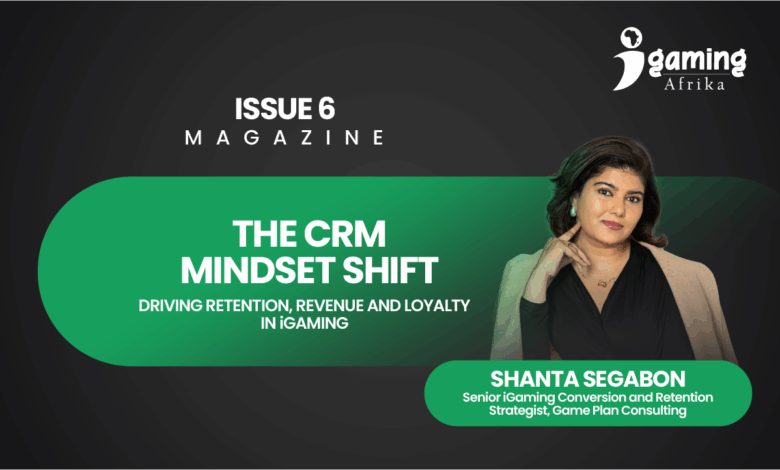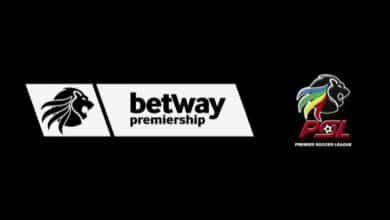Exclusive: Shanta Segabon unpacks Driving Retention, Revenue, and Loyalty in iGaming using CRM

In the ever-evolving iGaming industry, success depends on more than flashy games and aggressive acquisition campaigns; it’s about understanding, engaging, and retaining players through strategic Customer Relationship Management (CRM).
Speaking with iGaming AFRIKA Magazine, Shanta Segabon, Senior iGaming Conversion and Retention Strategist at Game Plan Consulting, draws on 17 years of experience across African and European markets to reveal why many operators are leaving money on the table, the misconceptions that plague CRM in gaming, and how a shift toward player-centric strategies can transform retention rates and revenue.
From tailored engagement and lifecycle management to the role of AI and gamification, Shanta offers a masterclass in building relationships that keep players loyal long after the first deposit.
iGaming AFRIKA: Can you tell us a bit about how you got into the gaming industry and how the journey is so far?
Shanta Segabon: Sure. I started my iGaming career seventeen years ago in Johannesburg and worked there for six and a half years before moving to Europe, still in CRM. While in Europe, I worked for a number of major operators, where I gained experience, from all angles, from a technology perspective, working with different teams and cultures, and working with different tools, especially on the gamification and engagement side of things, within the European market.
So, that was a great learning curve for me. And then a couple of years ago, I came back to South Africa, where I saw this huge need for CRM done better, within the South African and especially within the African market.
iGaming AFRIKA: If you were to define CRM, specifically within the gambling context, how would you define it? And what is one thing most people do not understand about CRM in gaming?
Shanta Segabon: CRM, firstly, stands for customer relationship management, and that extends from the beginning of the player funnel right through to individual or personalised, VIP-level customer relationships. The idea of CRM is to communicate in terms of content and timing, in terms of rewards, is to communicate to players as if you were communicating to them on a one-to-one level.
If you took, let us say, two markets at opposite ends of the world, Australia and the US. If you had US Players and Australian or New Zealand players in your database, the idea is to communicate to those two groups of people, who may be playing different products. One group may be playing casino, and the other may be sports bettors at different times because they are in different time zones. With communication that is tailored to the language, the value level that these players are at, and what engages them the best in terms of rewards or your loyalty program.
There are so many complexities to CRM, but in a nutshell, it’s all about communicating to a huge base of players as if you were communicating to them one-on-one. Then the other question was What is the biggest misconception about CRM? The biggest misconception about CRM is that it is all about email campaigns. It is about mass marketing and not tailoring your content or your communication to where in the world players are, which time zones they play in, the language they speak, or the types of rewards and bonuses that keep them engaged and retained.
iGaming AFRIKA: If you were to discuss the player’s life cycle from the first point of engagement to VIP handling and locking in the players to continually engage the platform, how would you discuss that?
Shanta Segabon: Firstly, something I learned while working in Europe with European operators is that there was a major shift around twelve, ten years ago, and many Swedish companies did player engagement a lot better than the rest of the world. We began viewing engagement as a precursor to retention. And coming from a company in South Africa, we did a lot of buying. We would send the player an offer; there was no way of engaging the player. The offers were simple “buy this, get that,” and we did not engage the player with any content or gamification or tools. And many of the Swedish gaming companies did that much better.
What you saw was that an increase in engagement leads to an increase in revenue and player retention, which is the objective. But more importantly, it keeps your brand top of mind for players who may be active on multiple operators. If you engage your players as opposed to having a transactional relationship with them, what it does is it keeps your brand top of mind every time the player thinks about gambling or playing online, because you have treated the player a lot differently than some of the other operators.
That is how you distinguish your business or your brand from the rest of the brands out there by really giving the player that individual experience. And part of that, while it seems very simple, is so often overlooked. That is the custom life cycle, and what that means is, if we put ourselves in the player’s shoes, how do we treat the player from the very onset, from the point of registration up to the player becoming a VIP, and whether the player’s dropped off at multiple points in that relationship, and how we’ve brought the player back.
Read Also: Exclusive: Conor O Donovan on Crypto and the Future of Gaming in Africa
In addition, this is important, and I think it is sometimes overlooked. If we speak about how we engage the player as an example: a player arrives, registers and may make a first or second deposit. But how are we treating that player differently from players who have been with us for months or even years? That treatment of new players has to be different. If you go into a store as a new customer at a high-end luxury retailer, you would be treated differently from an existing customer. You would be introduced to the product and might be given a tour of the store along with information on the best-selling products. An older, familiar customer would receive different treatment. So, we need to think about it in those terms.
As a new player signing up to a new brand, how should I engage this new player differently from a player who has been with the brand for a while? How do I turn this new player into a regularly active customer, and, inevitably, how do I encourage them to deposit more so that they can become a VIP? This is directly linked to revenue. There is a common misconception that CRM has no intrinsic link to revenue, but there is a clear connection between how well or how poorly we execute CRM and our revenue at the end of the day. If we retain more new players upfront, it means we push more players into our retention funnel where they deposit more and are active more frequently. Ultimately, it means we push more players into the VIP funnel, the ideal scenario.
However, what often happens is that we do not treat new players differently, and they have a bad experience at the casino or sportsbook and disappear. We have spent, and there is an acquisition cost for that player who has come in; they may have made one or two deposits, which does not cover our acquisition costs, so you can see how that affects revenue. From what I’ve learned, especially when you consider the flow for players and the team building around CRM, whatever structure is built around CRM shows that engaging players should not be transactional. It is very important to focus on existing players rather than relying solely on acquiring new players every time. If there are no structures in place, even the cost of acquisition cannot be recovered, and the cycle repeats, which ultimately does not benefit the brand.
iGaming AFRIKA: Can you discuss the possible impact lost in value caused by poor life cycle management, which CRM can adjust?
Shanta Segabon: I think the answer is quite simple and short: if there is no customer life-cycle management, and we’re not even considering evaluating player value or engaging players with offers based on their value, we’re talking about a very basic approach to life-cycle management. If that is not done and we do not have a good CRM team in place, one that is passionate and curious, we will see the operator bleeding money because we are spending, yet not retaining those players. I’ve seen potentially hundreds of thousands of dollars in acquisition costs that are not recouped because those players aren’t retained.
The big problem in Africa is that many operators are so focused on acquisition and driving players into the funnel, but not on keeping them in the retention funnel. Players are not loyal unless you give them a reason to be. So, if players are not engaged and there are no retention efforts, they will move on to the next brand and play there. If they are treated the same way, they may move to a third brand. In a very competitive environment like iGaming, we need to put our best foot forward, and engage players throughout the customer life cycle so that we retain them and maximise the value we get from these players.
iGaming AFRIKA: Beyond product and the platform itself, what would you say makes a good brand in this space?
Shanta Segabon: I started out my career at the company now known as Betway, and they have done a good job of it. From the get-go, they have always understood the importance of CRM and customer retention, arguably as important as new player acquisition. CRM and retention are often treated as afterthoughts by many operators. So let us spend millions on acquisition and getting players into the funnel, but CRM and retention are left behind. Sometimes it is too late because you are losing and bleeding players who could potentially have been valuable.
CRM, Betway, and companies in Europe like Unibet and some other Swedish brands do a good job of customer retention. They keep players active, and their messaging is tailored to where the player is within the customer life cycle, which is imperative to how well we retain a player. When you are speaking to a new player, the content you send is very different from what you would send to a VIP or to someone reactivating an old player. We must think about new players differently from how we communicate with active players or players who are dropping off in their activity levels. That is important and sometimes overlooked. But CRM is about tailoring the messages, bonuses, and rewards to where players are in the customer life cycle.
iGaming AFRIKA: How would you say African operators could shift from this brand – centered to player – centered decision-making process in their operation system?
Shanta Segabon: Number one is to hire the right people. You need a team, or a single custodian, in place who will serve as the custodian of a player-centric methodology. You also need someone within the organization to own that initiative and drive it consistently, because the product department or CS and other departments will continue with their own priorities. It is up to the CRM custodian to continually push how integrated CRM is across the business.
When the product team is developing a new feature, or when the CRM team is speaking to players, they should be driving a unified message that comes from CRM. I find that a common problem in the African market is the lack of alignment between the CRM department (or CS) and the product team, leading to everyone pursuing their own priorities. As a result, we neglect a unified, player-centric view of the customer.
To reiterate, the first priority for any operator looking to set up the CRM function is to have the right people in place, ideally a dedicated team or individual who will drive the importance of CRM throughout the business.
iGaming AFRIKA: Can you share with us a real-world example of a time CRM improved performance for a gaming operator you worked with?
Shanta Segabon: We did something to get more players in, or whatever the case was. I’ve worked for a US-facing sportsbook-focused brand, where a big revenue driver was the NFL. At the end of the season, you have the big Super Bowl. To increase revenue, we saw a solid lift, roughly 7–10%. Our approach was to allow players to place early bets. Traditionally, players would come in at the last minute on Saturdays to bet on the NFL final. We began taking bets earlier, starting on Wednesday instead of Saturday morning.
Additionally, we offered the majority of sportsbook players free spins on a casino game during halftime. While they were watching the Super Bowl, they received free spins. This approach helped in the long run because after the Super Bowl there’s a down season when sportsbook players often disappear for a few months before the new season starts. By engaging players who would ordinarily focus on sportsbook with casino free spins, we saw a portion of these players start betting on casinos. As you know, the casino product is always available, there is no off-season. So, these players got used to playing casino with the free spins, and after the NFL season ended, they returned to bet on casinos. This reduced the rate of player lapsing and increased retention among players who would have otherwise disappeared for several months before the next season.
iGaming AFRIKA: With technologies on the rise, especially with AI changing how things are done across several industries, how has this changed or affected CRM strategies?
Shanta Segabon: There has been a lot of change, and I think people are often sceptical about using AI. But after seventeen years in the industry, I can say the industry is very dynamic, and a big part of that is the rapid advancement of technology in CRM. We have CRM tools like Optimove or Smartco, along with gamification tools that help keep players engaged, and the technology is always evolving.
As we better understand player behaviour, we can adapt the technology we use, and AI is no exception. We need to embrace AI, as it can enhance the types of promotions we run and the content we send to specific segments of players, helping to keep them more engaged. AI also assists with segmentation and predicting future value of players. Many CRM tools offer add-ons that assess churn risk, looking at individual play activity. Rather than sending offers to everyone who hasn’t been active in the last month, AI can tailor offers to individuals who are likely to churn—delivering targeted incentives to those players.
What AI and machine learning teach us is to tailor offers, bonuses, and rewards based on actual player activity. For example, if you play every weekend, that’s your baseline; if someone else plays every two to three days, that’s a different pattern. Machine learning helps us understand these distinct behaviours within our database and tailor offers accordingly.
Read the full interview in our digital magazine:




















